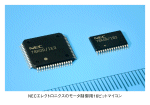The Ultimate Resource for Building Next-Generation Systems
SemiApps allows electronic design engineers to easily and quickly find product vendors who provide chipsets, application-focused ICs, customizable or programmable platforms and specialized components for particular applications. Each month we bring you our best online postings (www.semiapps.com/thismonth). Our choices, as presented here, are based on what other engineering readers like you looked at most during the previous few weeks
Readers Choice: The best new application-specific ICs

NEC Electronics is targeting energy-efficient motor control applications for its new family of 16-bit microcontrollers. Nineteen members of the 78K0R/Ix3 16-bit flash-based microcontrollers are aimed at Inverter Control control systems. According to NEC, fine-tuned control of motors and heating elements can deliver significant energy savings in products ranging from refrigerators and air conditioners to dishwashers and magnetic induction cooking appliances. These MCUs with 16-bit performance and 8-bit power consumption levels are ideal for such applications.
Among the features of the MCUs is the CPU’s power consumption of only 1.8 mW/MIPS; on-chip oscillators that are capable of driving timers at rates up to 40 MHz for fine-tuned inverter control and integrated hardware multiply and divide functionality for fast processing of mathematical algorithms.
Engineering blogs of the month

According to blogger Joanne DePeralta of BiTMicro Networks, debates over whether or not the era of solid-state disks (SSDs) has finally arrived have stimulated activity in quite a number of forums. She believes the advantages of solid-state disks over conventional hard drives have been highlighted with the stream of products being introduced to both consumer and enterprise markets.
Products using solid-state storage are now offered as a valid option to resolve complicated upgrades to accommodate highly demanding business processes, according to DePeralta. Up front, price is the biggest question, she says. Is it worth that much? Are the benefits you’ll get from a gadget equipped with an SSD equivalent to money you’ll need to shell out? Is there no other way to get that benefit without the price tradeoff? These are some of the issues that are covered in her recently posted blog at the SemiApps site.

In another very popular blog, Dave Wilson from Cirrus Logic raises the interesting issue of whether to use a sensor or go sensorless in motor control systems. After acknowledging that there are some cost and mounting issues to using sensors in these systems, he still believes that the shaft sensor will be with us for quite a while.
“Applications to prove my point abound,” says Wilson. He noted that he recently worked on a kitchen mixer design for a large appliance manufacturer that incorporated a 6-pole magnetic disk pressed onto the shaft of a universal motor, and a single Hall sensor was used in measurement of velocity. “Even though the added cost of the sensor assembly was negligible, it gnawed at me, and I set upon my quest to eliminate it. However, I soon realized that I could not develop a sensorless solution that was nearly as robust, or exhibited the same dynamic response. I eventually left the sensor alone and turned my attention toward other areas to improve the design.”
Motor control system designers face these issues day in and day out. Do you agree?
Design Classics Library: Application notes of note and more
Among the interesting application notes posted on the site come from Analog Devices. ADI’s networked entertainment reference design supports all leading high-definition video transport sources. The company’s new HDAnywhere networked entertainment platform distributes HD video content over all popular wireless and wired transmission transports, including ultra wideband, 802.11n, coaxial, phoneline, and powerline protocols.
The rapid growth of high-definition home entertainment systems has made the connections between an increasing number of sources and displays more difficult. High Definition Multimedia Interface (HDMI) cables support a limited distance, and content protection restrictions preclude most of the traditional interconnect solutions, according to ADI.
Also recently posted on the site is a power supply reference design from Power Integrations. Sample designs for a power supply from the company can be used to meet the efficiency requirements set by the California Energy Commission (CEC) and Energy Star, as well as many other regulations worldwide. The Reference Designs (DAKs) provide the essential materials to get started on a next power supply design. All kits include samples, a fully functional reference board, and complete documentation.
Marty Gold
Find out more on what visitors to SemiApps.com looked at most at www.SemiApps.com/thismonth.
Advertisement
Learn more about Electronic Products Magazine





